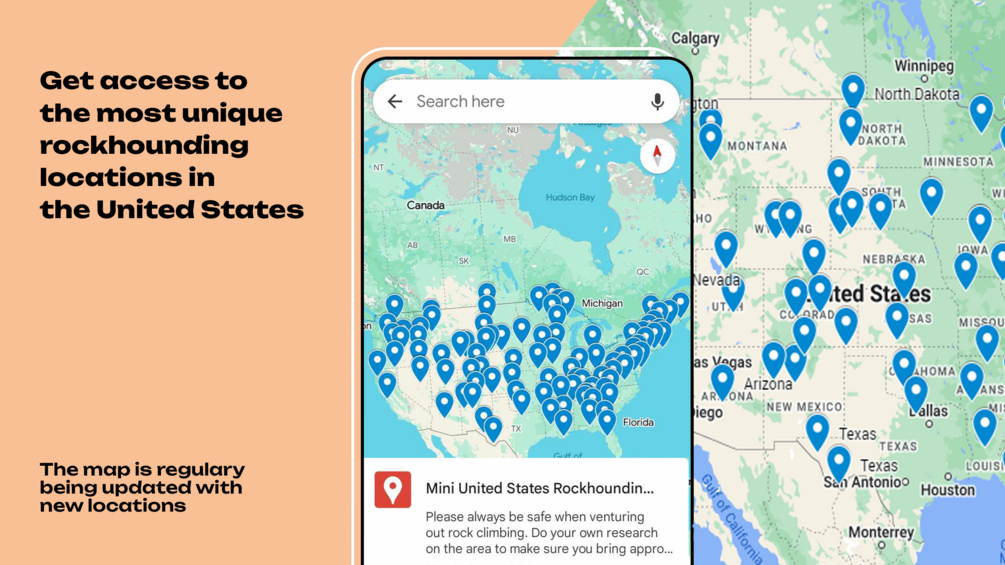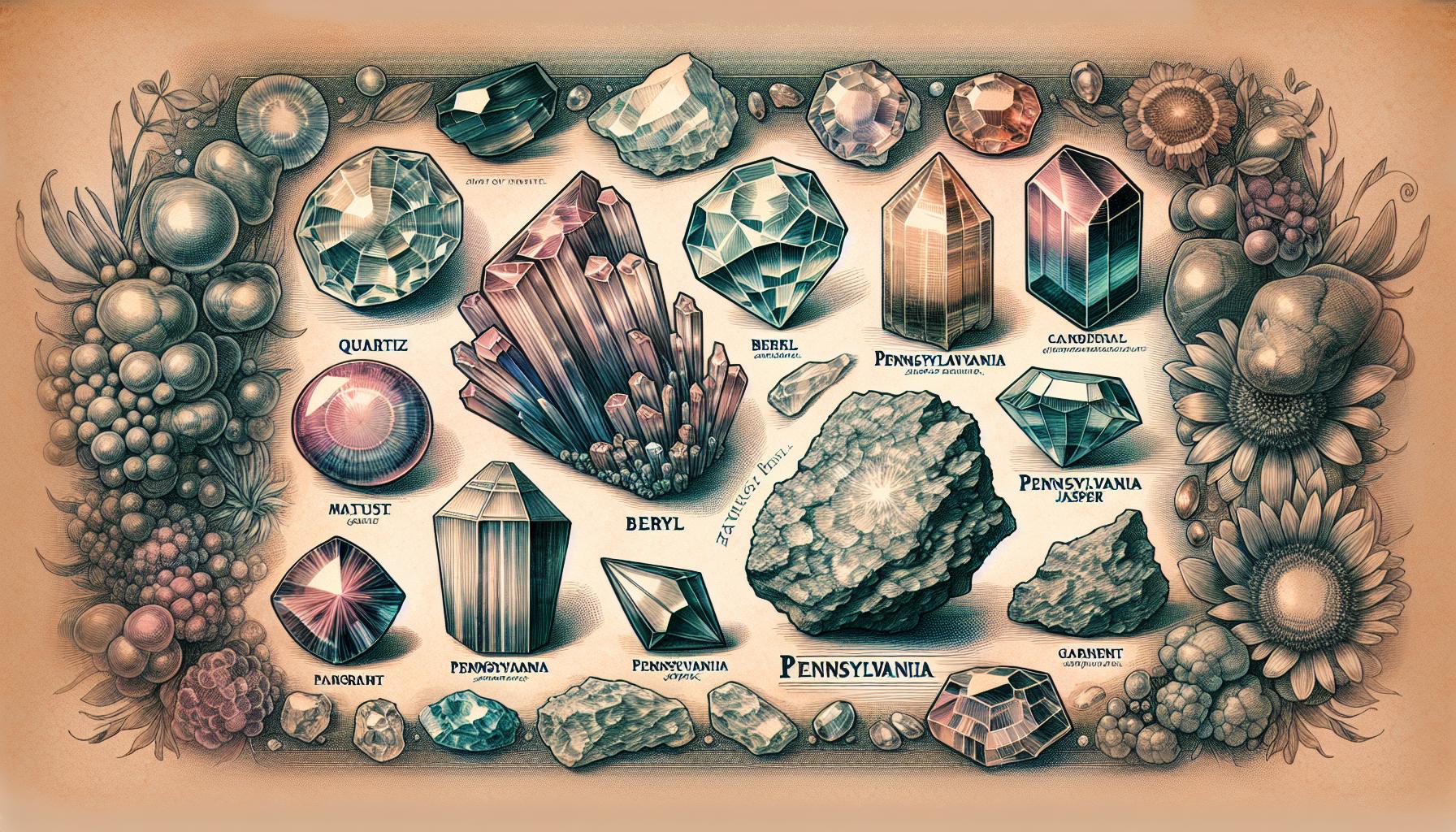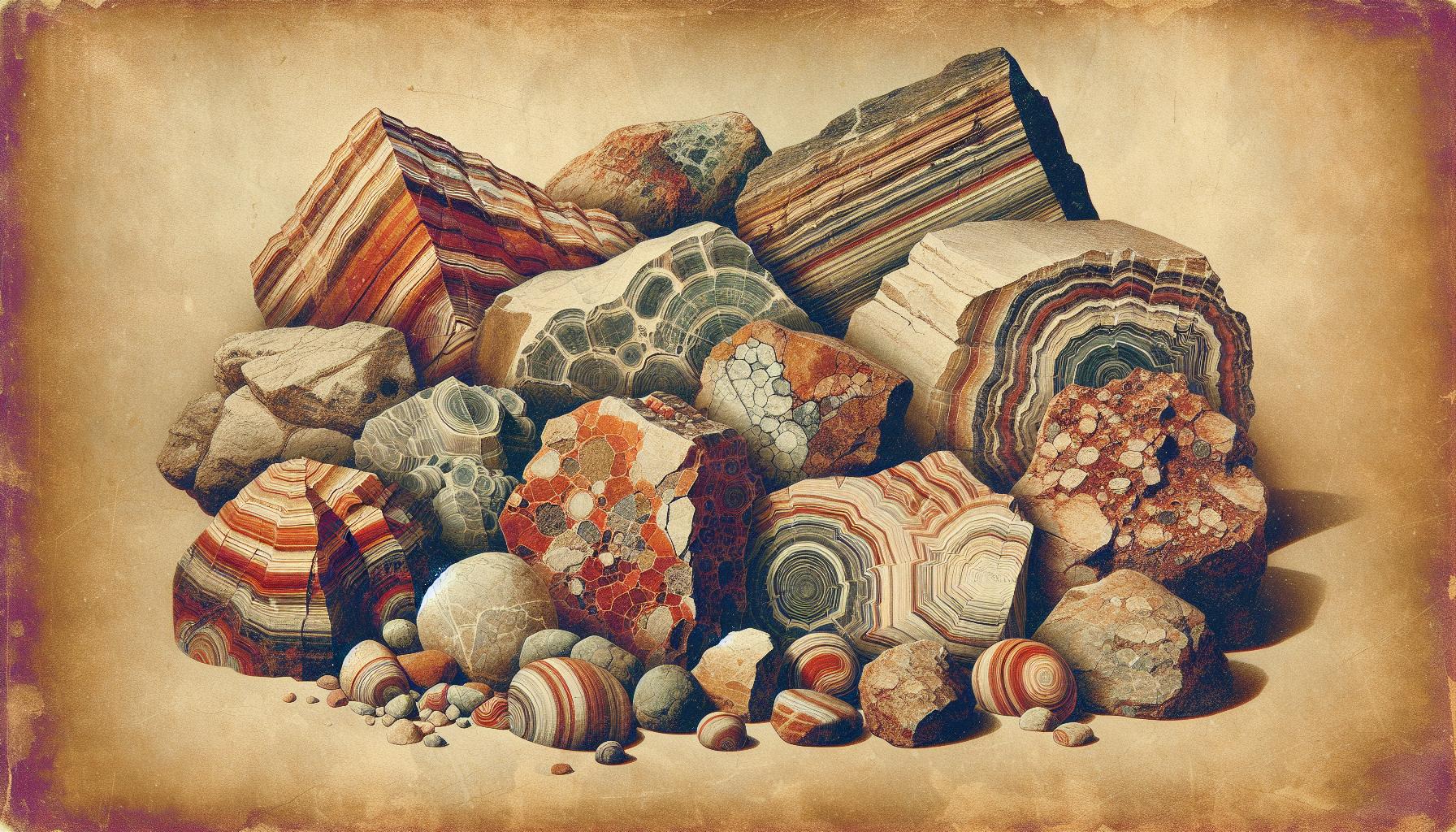Ready to unearth the treasures hidden beneath Pennsylvania’s landscape?
Your rockhounding adventure awaits in the Keystone State, where a wealth of minerals and fossils are ripe for discovery. Whether you’re a seasoned collector or a curious newbie, Pennsylvania’s diverse geology offers a playground for enthusiasts.
From the rolling Appalachian Mountains to the tranquil shores of Lake Erie, you’ll find spots teeming with geological wonders. You might uncover quartz crystals, fossils, or even the state’s iconic gemstone, the Pennsylvania amethyst.
Let’s dig into the top rockhounding locations and the treasures you can expect to find.
Uncover Pennsylvania’s dazzling rocks, fossils, and hidden gems responsibly with this guide to locations, safety tips, and legal must-knows for your next treasure hunt.
Get our FREE United States Rockhounding Map HERE

Pennsylvania Rockhounding Locations
You’ll discover that Pennsylvania’s diverse landscape holds numerous sites rich in geological treasures. Whether you’re a seasoned rockhound or just starting out, you’re bound to find locations that are as rewarding as they are picturesque. Here are some prime spots to add to your rockhounding itinerary.
Central Pennsylvania is home to a wealth of quarries known for yielding quartz crystals. In particular, the area around McAdoo is famed for its exceptional clear and smoky quartz specimens. Just remember to seek permission before entering quarry properties, as they’re often owned by private companies.
Eastern Pennsylvania boasts the historic Cornwall Iron Mine, where rockhounds can find magnetite, hematite, and goethite. It’s not only a site of rich mineral deposits but also a place steeped in industrial history, providing a unique backdrop to your search.
If you head over to Southwest Pennsylvania, you can explore sites around Pittsburgh for fossils and calcite crystals. The region was once at the bottom of an ancient ocean, allowing for an abundance of fossilized plants and marine life to be found in the shale and limestone deposits.
Near Lake Erie, in the northwest, beachcombers can scour the shoreline for beach glass and wave-polished stones. This area is less about the traditional dig-and-chisel rockhounding and more about what the waters deliver to the shores.
What you’ll find at each of these locations varies with the seasons and the careful work of fellow enthusiasts. You’ll want your rockhounding adventures to be both fruitful and respectful of the land, adhering to the motto, “Take nothing but pictures, leave nothing but footprints.”
To aid your search, here’s a quick reference for some of Pennsylvania’s most sought-after minerals and their common locations:
- Quartz Crystals: Central Pennsylvania Quarries
- Magnetite and Hematite: Cornwall Iron Mine, Eastern Pennsylvania
- Fossils: Southwest Pennsylvania Shale Deposits
- Calcite Crystals: Limestone Deposits in Southwest Pennsylvania
- Beach Glass and Polished Stones: Lake Erie Shoreline
What Gemstones are Found in Pennsylvania?

While seeking the thrill of discovery, you might wonder about the specific gemstones Pennsylvania hides beneath its surface. Pennsylvania is a treasure trove of gemstones, with something for every level of rockhound. The Keystone State is famously rich in a variety of gems, adding a colorful twist to your rockhounding adventure.
First off, let’s talk about quartz. It’s among the most abundant minerals found in the state, with varieties like clear quartz, smoky quartz, and the much-prized amethyst available. You can find sizable quartz crystals in the areas around McAdoo, renowned for their clarity and size.
If it’s luster you’re after, beryl should be on your radar. This gemstone, especially in its green variety known as emerald, can occasionally be unearthed in Pennsylvania. Beryl crystals are known for their hardness and are sought after for both jewelry and collections.
Perhaps you’ve set your sights on something uniquely Pennsylvanian? Pennsylvania Jasper is a local highlight, a fine-grained form of silicon dioxide. This gemstone has a rich history; Native Americans once used it to make tools and weapons. Today, rockhounds prize Pennsylvania Jasper for its array of colors and patterns.
Another highly sought after stone in Pennsylvania is garnet. Known for its deep red hue, garnet is a durable gemstone that’s often discovered in mica schists throughout the Southeastern region. Garnet’s distinctive color and durability make it perfect for both gem collectors and jewelry enthusiasts.
While you’re exploring, keep an eye out for sapphires and serpentine, rare but possible finds that can add a unique touch to your collection. Remember, patience and thorough searching are the rockhound’s allies on this quest.
What Sedimentary Rocks You Can Find in Pennsylvania?

As you delve deeper into the world of rockhounding in Pennsylvania, you’ll find that the state is rich in sedimentary rocks. Sedimentary rocks arise from the accumulation of minerals and organic matter over the millennia, and Pennsylvania’s geological history has made it a prime spot for these types of formations. One of the most common sedimentary rocks you can find here is sandstone. Ranging in color from tan to reddish-brown, sandstone in Pennsylvania bears witness to ancient rivers and deserts that once covered the region.
In addition to sandstone, you’re likely to come across shale. Shale is typically gray to black and forms in layers, which can contain fossils of ancient sea creatures due to Pennsylvania’s past as a seabed. By carefully splitting open the layers of shale, you might uncover a relic from an era long gone by.
Limestone is another sedimentary rock readily found in the Keystone State. Often lighter in color, it’s formed largely from the remains of marine organisms and can be an excellent material to hunt for fossils. Limestone areas may also lead you to discover calcite crystals, which can nest within this sedimentary rock.
If you’re on the hunt for sedimentary rocks that stand out, keep an eye out for ironstone concretions. These unique formations, sometimes called ‘fairy stones’, are hard masses formed by the cementation of sedimentary grains around a mineral nucleus, often creating intriguing shapes.
Here’s a quick list of sedimentary rocks you might come across:
- Sandstone
- Shale
- Limestone
- Ironstone Concretions
Note their characteristics and ideal locations to increase your chances of finding these rocks. Sandstone is prevalent in the Appalachian Plateau, shale is abundant in the Ridge-and-Valley Appalachians, and limestone spans across the Great Valley region. Keep your tools handy, and your eyes peeled; you’ll find that rockhounding in Pennsylvania is as rewarding as it is educational.
What Metamorphic Rocks are found in Pennsylvania?
When your rockhounding journey takes you through Pennsylvania, you’ll find that the state isn’t just rich in sedimentary rocks but also boasts a variety of metamorphic rocks. Metamorphic rocks are those that have undergone a transformation due to intense heat and pressure. In Pennsylvania, these rocks tell a tale of geological processes spanning millions of years.
Slate, once sedimentary shale, is a common metamorphic rock that can be found in eastern Pennsylvania, especially in the Lehigh Valley. Its fine grains and tendency to split into thin sheets make it easily recognizable. Home to historic quarries, the Slate Belt is a must-visit for enthusiasts looking to add to their collection.
Schist, characterized by its layered appearance and glistening surfaces due to mica minerals, is also prevalent in the Keystone State. You’ll often find schist adorned with other minerals such as garnet, staurolite, and kyanite, which make for particularly intriguing finds. The best places to hunt for schist are in the Piedmont and Blue Ridge regions of southeastern Pennsylvania.
Gneiss, with its distinctive banding caused by the segregation of mineral constituents, is another metamorphic rock widely distributed across Pennsylvania. Depending on the region, you might come across varieties of gneiss enriched with different minerals, including feldspar, quartz, and biotite.
| Metamorphic Rock | Common Locations in Pennsylvania | Distinguishing Features |
|---|---|---|
| Slate | Lehigh Valley, Slate Belt | Fine grains, splits into sheets |
| Schist | Piedmont, Blue Ridge regions | Layered, glistening surface |
| Gneiss | Widespread | Distinctive mineral banding |
What Igneous Rocks can You Find in Pennsylvania?
In your rockhounding adventures across Pennsylvania, you’ll discover that igneous rocks are part of the bountiful natural treasures strewn throughout the state. These rocks formed through the cooling and solidification of molten material, provide a unique window into the fiery depths of the Earth’s past.
Granite is one such igneous rock that you might encounter. Known for its grainy texture and durability, it’s commonly found in the northeastern parts of the state, especially in the terrain around Elk County. You’re likely to spot granites with their iconic speckled pattern of black, white, and pink minerals.
Another noteworthy mention is diabase, a dense, dark igneous rock predominantly composed of pyroxene and plagioclase feldspar. Diabase is abundant in areas around Gettysburg, where it surfaces in sills and dikes, providing a stark contrast to the surrounding sedimentary layers.
If your exploration takes you near the borders of York County, keep your eyes peeled for pegmatite: a coarse-grained igneous rock rich in quartz, feldspar, and mica. These rocks often contain large, eye-catching crystals and occasionally, gem-quality minerals. Pegmatite quarries are a favorite haunt for serious rockhounds due to their potential for extraordinary finds.
- Key Igneous Rocks in Pennsylvania:
- Granite
- Diabase
- Pegmatite
Remember, while hunting for these igneous formations, you’re also retracing the volcanic activity that once played a critical role in shaping the region’s geology. Pennsylvania may not have active volcanoes today, but the ancient igneous rocks you find are evidence of its fiery history. Rockhounding for igneous rocks not only offers the thrill of discovery but also a deepened appreciation for the state’s complex geological mosaic. So pack your gear and set out – there’s a whole world of crystalline marvels waiting for you beneath Pennsylvania’s surface.
Panning for Gold in Pennsylvania
While Pennsylvania may not be the first place that comes to mind when you think of gold prospecting, you’ll be surprised to know that panning for gold is a popular pastime in the Keystone State. Streams and rivers in Pennsylvania, especially in the southeastern parts, have been known to contain placer gold deposits.
York and Lancaster Counties are particularly notable for their gold findings. With a simple gold pan and some patience, you can enjoy the thrill of panning in waters where gold has been discovered previously. Remember that successful gold panning often requires permission to access certain streams or private lands, so always check local regulations before you start.
Gold-bearing streams in Pennsylvania include:
- The Susquehanna River
- Swatara Creek
- Conestoga River
- Wissahickon Creek
These waterways have histories of minor gold discoveries that continue to attract hobbyists. To maximize your chances of finding gold, you’ll want to pan in the areas where streams enter the larger rivers, as gold tend to settle at these confluence points.
When panning, it’s important to look for black sands; these are heavy mineral sands that often accompany gold. If you find them in your pan, you’re likely in the right spot to find some flakes or even small nuggets. Don’t expect large quantities, but do enjoy the process and the possibility of that shimmering color in your pan.
Equipment needed for gold panning doesn’t have to be sophisticated or expensive. At a minimum, you’ll need:
- A gold pan
- A sluice box (optional for increased efficiency)
- A shovel or scoop
- A snifter bottle for picking up fine gold
Safety should be your priority. The water in Pennsylvania’s streams can be cold, and conditions can change swiftly. Be sure to wear appropriate attire and never pan alone. Stay aware of your surroundings and always respect the environment by leaving any site as you found it.
Begin your gold panning adventure in Pennsylvania with these insights in mind, and you may just strike it lucky with some glimmering finds from the state’s rich waterways.
Rocks and Minerals Found in Pennsylvania
As you delve into rockhounding in Pennsylvania, you’ll discover a diverse range of rocks and minerals embedded within the state’s rich geological tapestry. Pennsylvania is well-known for its coal regions, but there’s much more beneath the surface if you know where to look.
Notable Finds and Locations
Discovering quartz crystals in Pennsylvania is a common delight for rockhounds. These crystals are prevalent at locations such as the Pine Grove Furnace State Park. Moreover, the state’s slate belt is a prime spot to find fossils and trilobites, remnants of ancient sea life that once thrived here millions of years ago.
- Quartz Crystals: Pine Grove Furnace State Park
- Fossils: Slate Belt
Another gemstone that captures the interest of many is garnet. You can find this semi-precious stone scattered around the Delaware River, especially near Easton. The river beds and old mines are hotspots for rockhounds seeking garnet.
- Garnet: Delaware River near Easton
If it’s variety you’re after, the Mineral Hill region offers a spectrum ranging from azurite and malachite to silver, lead, and even pyrite – often dubbed “fool’s gold.”
- Azurite and Malachite: Mineral Hill Region
- Silver and Lead: Mineral Hill Region
- Pyrite: Mineral Hill Region
Pennsylvania also boasts deposits of calcite and dolomite, with the State Line Chromite District being one of many locales where you might stumble upon these finds.
- Calcite and Dolomite: State Line Chromite District
Equipment and Techniques
Having the right gear can make a significant difference in your rockhounding experience. You’ll need a sturdy hammer, chisels, gloves, and protective eyewear to safely extract these treasures. Remember, with patience and persistence, you may uncover specimens to expand your collection significantly.
Remember to respect property rights and secure any necessary permits before exploring these sites for rocks and minerals. Happy hunting as you explore the wealth of geological wonders that Pennsylvania has to offer.
Where Can I Find Fossils in Pennsylvania?
Pennsylvania, with its rich geological history, is a top spot for fossil enthusiasts. When you’re scouring for ancient treasures, Montour Preserve in Danville is a prime location. The fossil pit here is well-known for its abundance of Pennsylvanian-age plant fossils, dating back around 300 million years. You’ll find an array of ferns and impressions of prehistoric vegetation that once thrived in Pennsylvania’s warm, moist climate.
Another noteworthy location is Red Hill, near North Bend, famous for housing some of the earliest known reptile and amphibian fossils. The intrigue here lies in Devonian-aged rocks approximating 370 million years old. This site has unearthed fossils of the primitive fish Hynerpeton bassetti, which gives a glimpse into the early evolution of tetrapods, creatures that were stepping onto land for the first time.
Beltzville State Park offers another fossil hunting experience where you may come across marine fossils due to its past life as a seabed. Look out for brachiopods, bryozoans, and trilobites that swam in the shallow seas during the Paleozoic Era.
To unearth these ancient remains:
- Research the area you plan to explore.
- Obtain permission if required, as some sites may be on private lands or protected areas.
- Bring proper tools, such as a geologist’s hammer and protective eyewear.
While free to access, these sites do have rules to protect natural heritage – ensure you’re aware of them. Additionally, you’ll maximize your chances by following previously disturbed ground, which may reveal hidden fossils. Remember, rockhounding and fossil collecting can be impactful activities; always strive to leave no trace behind to preserve the site for future generations.
Expert tip: Engage with local rockhounding groups or forums before your visit. Many enthusiasts share their experiences and may offer valuable insights on where to find specific types of fossils in Pennsylvania.
Pennsylvania Rockhounding Laws & Regulations
Rockhounding in Pennsylvania isn’t just about where to go and what to find — it’s equally critical to respect the laws and regulations that govern these activities. Your awareness of the local laws is essential for a responsible and legal rockhounding experience.
Before you set out, ensure that you have clarity on the ownership of the land. Public lands often allow collecting for personal use, but the rules can vary widely. State parks, for instance, have strict guidelines that prohibit the removal of rocks, minerals, or fossils.
Private lands require a different approach. Always seek permission from the landowner before you enter and collect rocks. Trespassing can result in legal consequences, so it’s better to play it safe than risk it. Furthermore, when you’re given the green light, ensure that your actions do not cause any damage to the property.
For national forests and BLM-managed lands, the Bureau of Land Management has issued a “use it but don’t abuse it” policy. Always stick to the following guidelines:
- Rocks and minerals should be collected in small quantities for personal use only.
- Avoid using heavy equipment or explosives.
- Don’t disturb wildlife or cause environmental damage.
- Ensure that your dig sites are not noticeable after you leave.
Fossil collecting carries its own set of rules. For instance, plant fossils might be collected freely, but vertebrate fossils, such as dinosaur bones, are protected and cannot be taken without scientific permits. Research ahead of time to avoid unintentionally breaking these rules.
It’s crucial that you familiarize yourself with the Paleontological Resources Preservation Act (PRPA) which governs the collection of fossils on federal lands. The act outlines what’s permissible and seeks to preserve significant paleontological sites.
When in doubt, turn to local rockhounding clubs or the Pennsylvania Geological Survey for guidance. They often have the latest information on the legalities and best practices for rockhounding in the state. Remember, staying informed not only keeps you within the bounds of the law but also helps preserve Pennsylvania’s geological wonders for everyone to enjoy. Keep exploring responsibly and enjoy the rich geological diversity that Pennsylvania offers.
Rockhounding Tips for Beginners in Pennsylvania
Starting your rockhounding journey in Pennsylvania can be a thrilling experience. Whether you’re scouting for fossils or crystals, it’s important to come prepared. Here are some essential tips to get you ready for your rockhounding adventures.
Gearing Up: Essential Tools for Rockhounding
To make the most out of your rockhounding trip, you’ll need the right tools. These are some of the essentials:
- Rock Hammer: A sturdy rock hammer is crucial for extracting specimens.
- Chisels: Different sizes will help you pry rocks from their beds.
- Safety Goggles: Protect your eyes from flying debris.
- Gloves: Durable gloves will safeguard your hands against sharp edges and dirt.
- Backpack: A strong backpack will carry your tools and finds.
- Field Guide: Helps in identifying rocks and minerals.
- GPS or Map: Keep from getting lost with a reliable GPS or a detailed map.
Remember, the better your gear, the more enjoyable and productive your hunt will be.
Safety Tips While Rockhounding
Rockhounding is fun, but staying safe should always be your top priority:
- Stay aware of your surroundings: Keep an eye out for potential hazards like loose rocks and steep cliffs.
- Tell someone your plans: Always inform someone where you’ll be and when you expect to return.
- Dress appropriately: Wear sturdy boots, long pants, and weather-appropriate clothing.
- Stay hydrated: Carry plenty of water, especially during the warmer months.
- Be wildlife-wise: Understand how to react if you encounter wildlife.
Following these safety tips will help ensure that you have a safe and enjoyable experience.
Legal Guidelines for Rockhounding Enthusiasts
While rockhounding can be rewarding, it’s essential to do it responsibly:
- Land Ownership: Ensure you’re not on private property unless you have permission.
- Collection Limits: Familiarize yourself with any restrictions on the amount of material you can collect.
- Protected Areas: Some areas may be off-limits to rockhounding to protect ecological or historical values.
- Permits: Certain locations may require a permit for collecting. Check with the Pennsylvania Geological Survey or local authorities.
- Leave No Trace: Strive to leave sites as you found them for others to enjoy.
By respecting these guidelines, you’ll help preserve Pennsylvania’s natural heritage and ensure rockhounding remains a pastime that everyone can enjoy.
Conclusion: Pennsylvania Rockhounding Map
Armed with the right tools and knowledge, you’re ready to explore Pennsylvania’s diverse geological offerings.
Remember to prioritize safety, respect the environment, and adhere to legal guidelines while indulging in your rockhounding adventure. With a sense of responsibility and the thrill of discovery, you’ll uncover the hidden gems that lie beneath the Keystone State’s surface.
Happy rockhounding!







